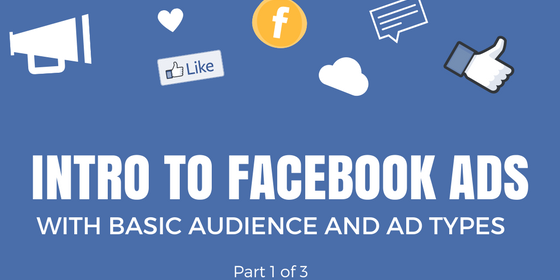With 1.8 billion active users on Facebook (which is about one fifth of the entire world’s population) brands are finding it increasingly difficult to organically reach their target audience. To make matters worse, Facebook introduced a new algorithm update which now favours posts from individuals instead of Pages because people were complaining about seeing promotional content too often. It’s unfortunate that the advertisers who likely instigated this algorithm change were probably just displaying poorly targeted ads or using irrelevant copy.
So how is a company able to reach their audience on a website or app where one fifth of the world is spending their time? They’re taking advantage of Facebook’s unbelievably robust and effective advertising platform. Companies that are accustomed to using AdWords will need an introduction to Facebook ads so we’ve created this three part series:
Part One: Intro to Facebook Ads with Basic Audience and Ad Types
Part Two: Defining Your Objective and How to Reach It with Facebook Ads
Part Three: How to Get Ridiculously Granular When Segmenting Your Audience on Facebook
Thanks for joining us in this series! Let’s dive in.
Why is Facebook Becoming a Viable Advertising Option?
You Can Create Engaging Ads
There are different ad formats to choose from including image, video, product image carousels, and slideshows. This gives marketers an opportunity to craft engaging ad copy with enticing, powerful visuals as well.
EVERYONE is on Facebook
Businesses no longer question whether or not their typical customers are on Facebook because EVERYONE is on Facebook. Also, the lines between using it for business and personal use are becoming blurred. It’s just a matter of finding them (stay tuned for part three of this series and we’ll teach you!).
Supports Different Goals
Facebook has a ton of data on its users. Marketers can use this data to their advantage by leveraging specific info to help reach their unique goals. Looking to increase your number of Page likes? Target individuals who have liked similar Pages. Or if your goal is to increase product sales, use the carousel ad format to display different items. Facebook has dozens of different options for reaching different business goals.
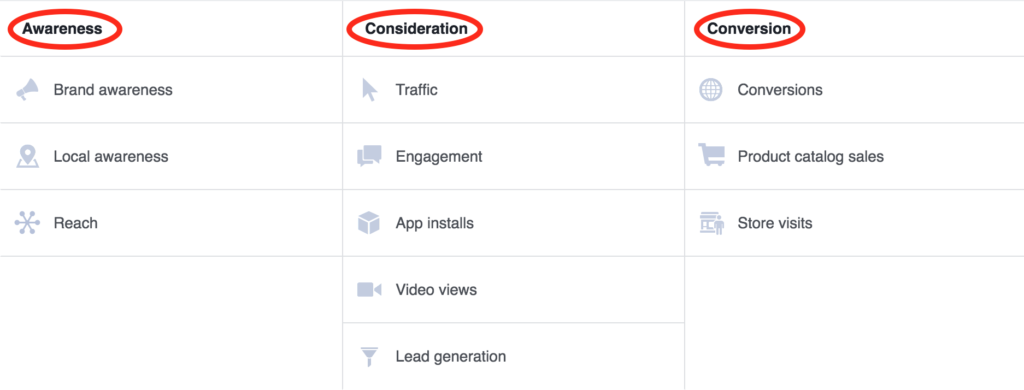
Reduction in Organic Reach
With over 50,000,000 brands on Facebook posting an average 1.48 times per day, reaching people organically is becoming nearly impossible. Further, Facebook’s goal is to show people the posts with the most engaging content. So if your sad little post didn’t get a lot of likes and comments after hitting publish, the chances of it appearing in someone’s news feed later on are even slimmer. This change has benefit individuals as now they see more engaging and relevant content, but forces businesses to boost their posts or place ads in order to be seen (we see what you did there, Facebook).
Low Search Volume
Placing paid search ads helps customers find your business who are avidly searching for an answer, and ultimately a business. Facebook ads work the other way around. They help businesses find their customers. Low search volumes are telling businesses that people aren’t really searching for those keywords, but they are interested in engaging with the content. This is where Facebook ads are useful.
Competitive CPC in Google Adwords
Wondering how Google makes all its money? PPC advertising! 97% of the company’s revenue comes from this stream. The average CPC in Adwords ranges from $0.35 to $5. Facebook’s CPCs are typically much lower. The average CPC on Facebook is less than $1. The most expensive keyword in Adwords is ‘insurance’ at $54.17! As businesses recognize the increasing competition and CPC, they are opting for a less expensive ad platform.
Several Placements
The news feed isn’t the only spot you can place ads on Facebook.Depending on your objective, there are a number of different placement options. You can choose to display your ad in the right column (for desktop users only), on Instagram, as an Instant Article, or on the audience network. Stay tuned for part two of this series for tips on where you should be placing your ads!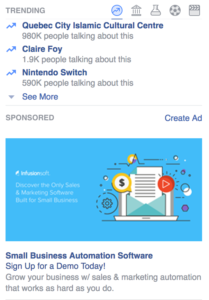
How Does Advertising on Facebook Work?
Facebook advertising works on a similar auction-based system that AdWords does. The maximum bid is calculated based on the estimated cost per thousand impressions.
There are three different options for who you can show your ads to:
Core Audiences
Creating a core audience involves define the group based on their location, interests, and demographic information. This is done within the Facebook ad platform.
Custom Audiences
A custom audience is a targeted audience of people that either you provide to Facebook or that you create using a Facebook Product like the Facebook Pixel or Facebook SDK.
From Your Sources – Target Audiences that you upload from a list of contacts. You can upload lists from:
- Your CRM
- Contact lists in a spreadsheet
- Contacts on Facebook
From Facebook Pixels (Most Popular for Retargeting)
Using the Facebook Pixel for Retargeting, you can track which pages people visit, how long they are on a page, and if they convert. This is also the type of targeting used for abandoned cart retargeting ads, using the Custom Audiences function.
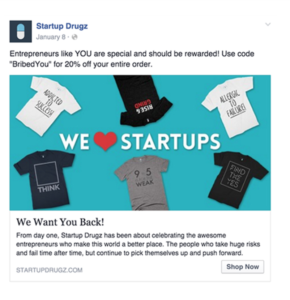
Source: https://www.shopify.com/blog/115169861-6-types-of-facebook-ads-that-will-win-customers-and-keep-them-coming-back
Lookalike Audiences
Businesses can create a lookalike audience by finding other individuals who fit the characteristics of your existing customers. You’ll need to upload a list of customers or define them in the Custom Audiences tool.
Stay tuned for part three of this series where you’ll learn about how to segment your audience to get the best results from your Facebook ads.
Facebook Ad Types
There are a number of different types of ads, depending on your objective. We’ll cover more in part two of this series, but here are some examples from each type. The call-to-action in the bottom right corner of the ad will usually indicate what the marketer’s goal is.
Lead Generation
When a business’ goal is to capture an email address, they can leverage the lead generation ads. Users don’t have to leave Facebook to fill out the form. The ad below showcases a video as the advertiser’s visual with the intent to get the user to sign up. The three images below depict the conversion process:
 ->
->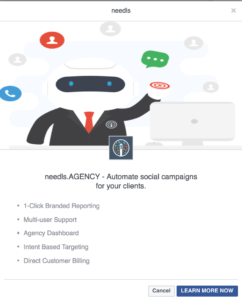 ->
-> 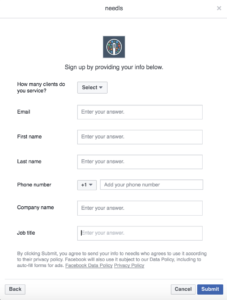
RELATED READ: How to Save Time and Streamline Your Conversion Funnel
Dynamic Product Ads (DPA)
DPAs allow marketers to showcase different products within the same ad in the hopes of getting a sale. Notice the arrows in the example below for users to scroll through the catalogue of items. Marketers need to be careful with DPAs. Showing irrelevant products to someone can create a poor user experience. Talk to an advertising expert to ensure you’re segmenting as narrowly as possible.
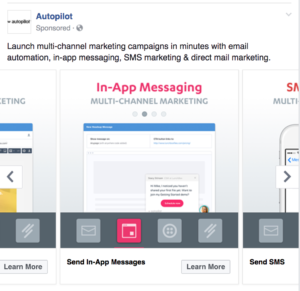
Cart Abandon Retargeting
Typically using the Facebook Pixel, eCommerce businesses can display ads for the exact same products they left behind in their cart. The copy in retargeting ads needs to differ from every other ad type. Be sure to call out the fact that you’ve recognized that the individual left a product behind and offer an incentive to complete their order (see example above from Startup Drugz).
Traffic Generation
A “Learn More” button in the bottom right corner of an ad usually aims to boost traffic. The user is drawn in with enticing copy and urged to click through to the marketer’s website to read more about the solution and eventually convert.

Page Likes
Not all advertisers are looking to make a sale from their Facebook ads. They will often place different types of ads to align with the different buyer’s journey stage the user is in. Businesses can place an ad with the goal of getting more page likes. The button is within the ad and doesn’t require any additional clicks. If this is an ad your business will be placing, be sure the copy aligns with your objective.
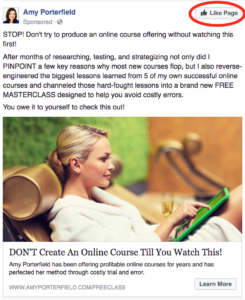
Boost Post
You’ve probably published something to your company’s Facebook Page and noticed the ‘Boost Post’ button. Boosting a post gives you the option to choose a new audience and your budget. Facebook will show you how many people it will show your ad to depending on your audience and budget.
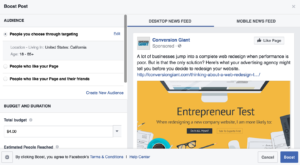
Facebook Advertising Best Practices
We’ll be sharing tips throughout this series but as far as basics goes, the best advice we can offer is to TEST, TEST, TEST. There are so many different ad formats and types and billions of combinations of audiences you can create. Create separate campaigns leveraging the options available to you. Another great way to test your ads and determine what’s working is to split or A/B test. Change one element at a time and run both versions the exact same way. From there, the Insights tool will allow you to see which one is working so you can base your other campaigns around the successful ad’s elements.
Want to be the first to know when part two of this Facebook advertising series is published? Sign up for email updates here.

